Each year we add yet another set of digital marketing trends and predictions to our collection. Most of them come true. But this year had a few surprises in store (who knew Zoom was going to become a verb, overnight?). And it challenged me to think differently, which led to the realization that predictions are useless without getting ready for when those predictions come true. And in many cases, predictions are just extensions of something that’s already existing, but if you’re not already up to speed, it may be hard to take advantage of what’s new.
Here is an example – we predicted shopping checkout within Instagram itself would become a reality, and it did in Aug 2020. BUT only for those who had the ability to set it up (it was fairly easy for those using Shopify, but not so much for others) and those willing to pay the pretty high fees – “5% per shipment, or a flat fee of $0.40 for shipments of $8.00 or less.” It was exciting news, but not a good fit for many.
So let’s dive into these 2021 digital marketing trends in a practical way.
Digital marketing trends and what to start doing now.
1. Get Ready for Digital Marketing Getting Ever More Technical, Outpacing Talent Development
According to Clevertouch’s “The State of MarTech 2020/2021,
“Only 28% of marketers view their in-house talent as competently trained in marketing technology – a talent deficit further accentuated by the fact that only 18% of senior marketers are using an external partner or agency to upskill their employees.”
This has been trending in digital marketing for years and it’s reaching a critical point – every single aspect of digital marketing requires some level of “math.” We often talk about “the algorithms” of search and social networks. We talk about “optimization” and “personalization.” All of those require technical skills or a good understanding of the science and technologies that power the digital networks we use to reach our target audiences. We need the proper tools, we need to learn how to use them and we must apply proper reasoning more like that of an engineer.
We can’t optimize without being able to test and make an accurate read of the data and use that read to make the next measurable marketing move. And we can’t optimize fast enough to control costs, without the right tools. And many of the tools needed require some fundamental technical knowledge. For example, to optimize Facebook ads results, you’ll want to get the Facebook pixel properly installed on your website. Even if you have a tech team doing the installation, if the marketers don’t understand the fundamentals of how the code works, you may not be able to fully tap into all that the pixel installation has to offer. Or know where to look when noticing a data aberration.
Clevertouch’s CEO, Adam Sharp, said:
“The report clearly demonstrates a striking divide between marketing talent and capability and investment in the right technology. As industry starts to move again, the war for talent has never been more relevant than now. However, the research also indicates that 2021 will see a big increase in martech investment. CMO’s must decide where to prioritise investment, whether that be on more marketing technology, or addressing the growing talent deficit in the industry.”
Talent gets my vote in this case. Technology can’t magically make results happen on its own.
As trendy as they are, put a pause on classes for how to make TikTok videos and Instagram reels (but I’ll share some TikTok marketing tips later). Invest in education, for yourself or your team members.
Here are some areas to focus on:
- How to properly conduct A/B testing: from audiences sizes, to what your performance indicators will be, and to the idiosyncrasies of each marketing platform. For example, you will learn that how Facebook establishes the winner of an A/B test is not the same as your email marketing platform. Which is the one to trust?
- Whichever martech platforms you choose to invest in, learn the ins and outs. Don’t ignore features because you’re concerned that learning takes too much time.
- Take a statistics refresher course.
- Take a coding class.
- Learn how what you use or depend on is engineered.
I’m sure there are many other options. Let me know and I’ll add them to the list.
2. Invest in Developing Trusting Relationships
According to Deloitte’s CMO Survey, over the next 12 months, customers will predominantly prioritize trusting relationships.
This is another one of those areas where content marketers have been shouting from the rooftops for years – “focus on building trust!”
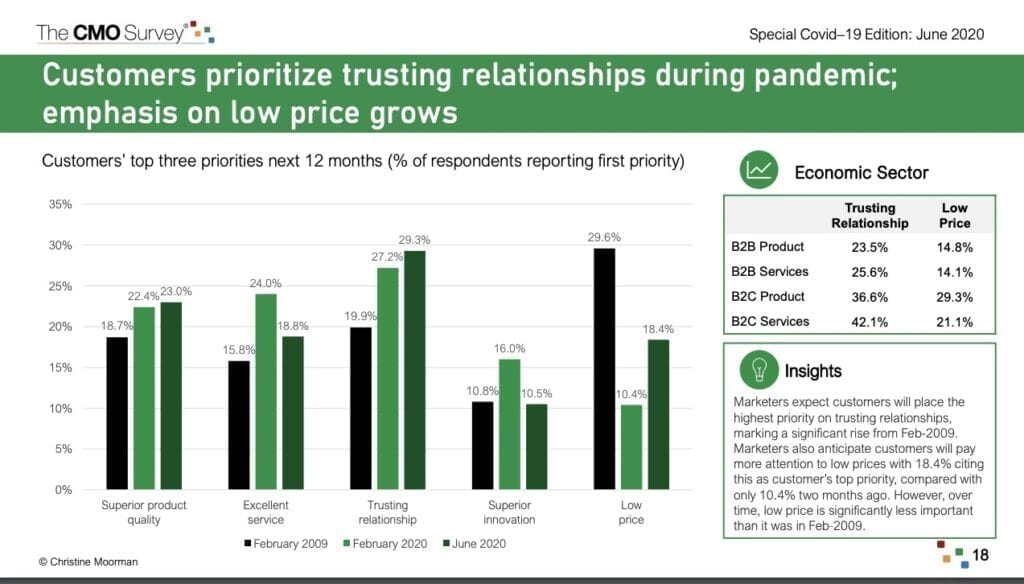
Now we have a graph and numbers. And we like numbers. Follow the numbers.
Here are a few things to explore when it comes to trust relationships:
- Share behind the scenes, using mythological patterns of story-telling – stories of genesis, or rising from the ashes.
- Feature your customers. The good ones will not mind you writing about them. The great ones will let you interview them and share the content with their audiences.
- Feature your employees
- Don’t ever assume that people read your mission page. Make it a constant in your content mix.
- Apologize promptly when an apology is due
- Participate in the online communities that your target audiences participate in, with genuine intent and curiosity
- Deliver what you promise in your marketing
- Seek to do good with your marketing
During and Post-COVID customers are more likely to acknowledge your attempts to do good.
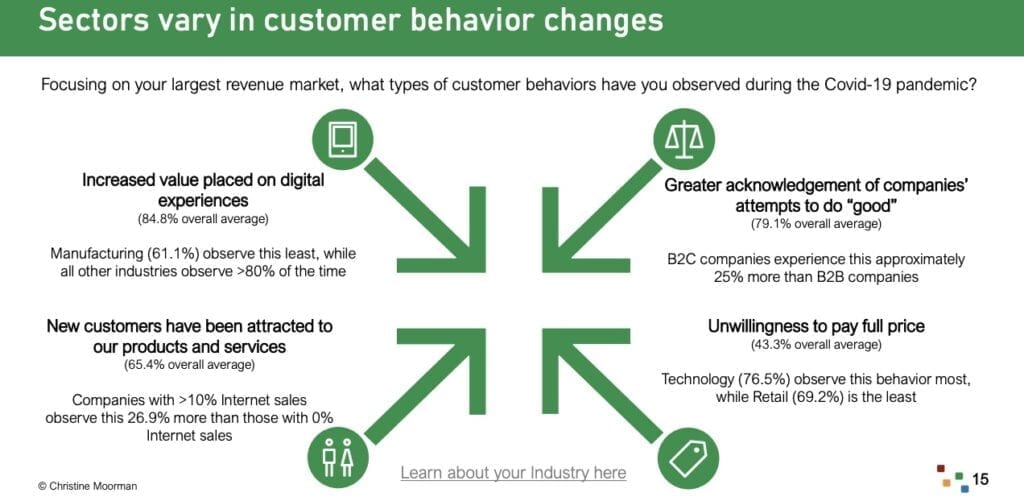
Marketing is not just about creating content and working with algorithms. “Doing” is part of it too. So watch for opportunities to do good, not just sell. Allow yourself to make it a common part of your marketing, not just a Giving Tuesday campaign.
3. Rethink Influencer Marketing
Starting back in 2019 we saw a rise in demand for influencer marketing campaigns. I expect the trend will continue in 2021 but with more twists.
Influencer marketing will shift closer to native advertising. We will see more disclosures and transparency, more native tools, from the social networks themselves, to facilitate collaborations. For example, TikTok were proactive in being facilitators to match brands with influencers, through their Creator Marketplace, a platform for brand and creator collaborations. Facebook/Instagram expanded features to tag and disclose collaboration with brands in advertising.
In the cannabis, tobacco, and guns industries where paid advertising on the large search networks and social networks is not possible, influencer marketing takes the place of paid advertising.
As the space matures, the possibilities are endless – from an abundance of social networks for every niche, to an expansion of P2P communication options; from one-off campaigns to long-term partnerships; from product offers to equity deals (interesting discussion below from @ianrborthwick), there are plenty of options even for the smallest brands.
What to focus on next?
Take a more intentional approach to influencer marketing, by developing programs. Think of them as influencer marketing campaigns instead of “working with influencers.”
- To not get distracted by all the options, choose your channels and influencers wisely.
- Start with goals, then pick the channels. Do not move on to finding influencers until you know that the results you’re looking for can be achieved through the channels you choose. And figure out how to measure results and what measurements will matter to you before selecting influencers. I wrote an influencer marketing ebook and developed a toolkit to help you with this process.
- Develop relationships with influencers rather than seeing them as ends to a means. Invest in them and they’ll invest in you.
Get our influencer marketing toolkit to build a better influencer marketing program next year.
4. Get Good At Short(er) Snappy(er) Videos ala TikTok and Instagram Reels
Gifs, Instagram Reels, TikTok videos are all here to stay. Last year we said a 30-second video is ideal. Let’s now talk about the hottest social media marketing trend, the 15-second videos.
The hardest part about producing Reels or TikTok videos is the concept, not video editing. Editing can be done off the platform.
Don’t be scared of Reels or TikTok videos. You’re not supposed to make a dance video. Think of these videos as editing clips together to send a message. And adding text on video. And doing all of that straight from the social network’s app itself. ‘Later,’ the Instagram management platform has an awesome article on how to master the techniques of Instagram Reels.
Catchy ideas and planning will be much more important to your success with Reels and TikTok than knowing how to edit.
Here are some content ideas (btw these apply to any social network):
- Cover current events – a weekly quick video that incorporates headlines and even screen grabs of news stories in your industry
- Create a voice Q&A challenge. Record yourself asking three questions while answering them with text on video only. Then encourage people to copy the sound of the video (Instagram lets you create a Reel using someone else’s sound content) and share their own answers. Here’s an example from @yoursocialteam
- Show a recipe. Every industry has recipes. Whether it’s a process or a list of priorities or principles or values etc.
- Create quick features of accounts that you think deserve being highlighted. For example, for Giving Tuesday, highlight organizations you support through a reel.
- Celebrate. Celebrate customers, employees, hallmark holidays, you name it. Who can resist wanting to be part of a celebration?
5. Prepare Your Data-Collection and Management for more regulation + more privacy and content rules
As of Dec. 8, Apple requires developers to report on their data collection for a wide range of categories and will present users a “nutrition label” for privacy. When the EU’s GDPR and California’s CCPA went into effect they mostly left the responsibility with individuals to understand what their rights are and take action to protect their own privacy. Apple’s move is meant to make it clear to users what’s being collected by each app.
On the regulatory front, Section 230 has been under attack and the left and the right and the center are unhappy with how little or how much the social networks are doing to prevent misinformation. This is going to continue being an issue in 2021 as countries will start public vaccination campaigns and there will be plenty of conspiracy theories spreading across social networks.
What all of this says is that we are heading for more regulation. Much of which is long overdue and even the founders of Facebook and Twitter agree on this one.
What you can do to be prepared:
- Clean up your data – if they haven’t opted in or haven’t opened your emails in a year or more, remove them from your lists. Or run an unsubscribe campaign. Trust me, cleaning up your lists will lead to better results and better trust scores from internet service providers.
- Make sure that every record that enters your system is tagged with the source and with whether or not they agreed to be marketed to.
- Make sure your systems are aligned, so if someone asks that all traces of their data be deleted, you have the ability to do it.
- Do make sure that you abide by GDPR and CCPA rules even if you’re not in Europe or California because what’s to come will not be too far from those.
- Freshen up your Privacy Policies and Terms of Use, especially if you’ve installed pixels since the last time you updated them.
6. “I don’t know what’s working” Will Be on the Rise, But There Will Be Help for Those Who Seek It
When a lot of change happens there will be a lot of “I don’t know” going around. And since many of the digital marketing channels we use can change on a daily basis and at a minimum a few times a year (like the Google search updates), there will always be a lot of things we don’t know. However, a few areas cause more headaches than others:
- MarTech overload
MarTech choice anxiety is one of the leading issues. Have you seen this map of MarTech in 2020?
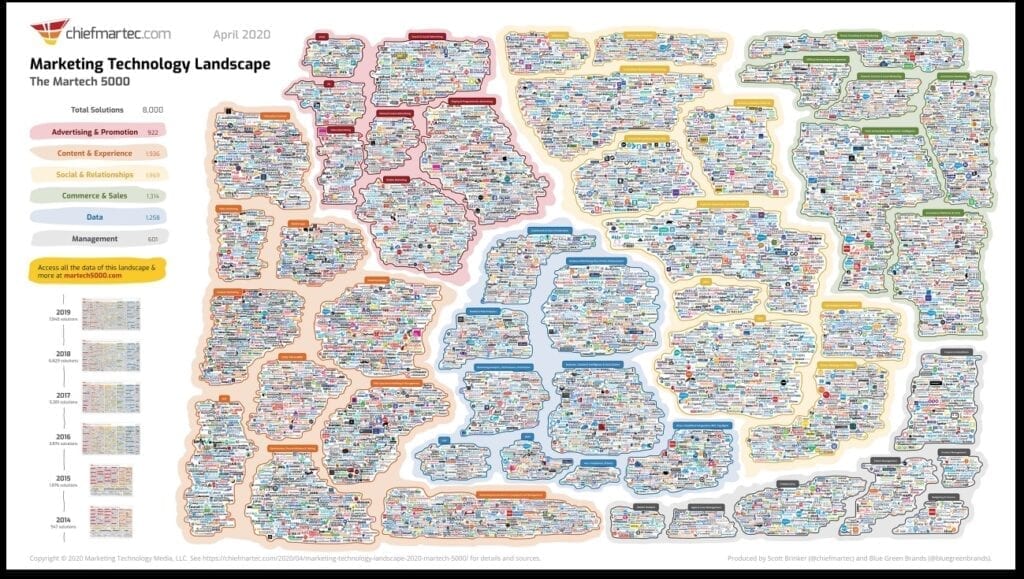
The increase in channels, options by channel, advertising networks, automation systems, chat bots, video marketing, AI, CRMs, content marketing systems, email, SMS, chat, video chat and on and on it goes, is mind-boggling.
How do we make sense of it all?
Every year Gartner publishes the Hype Cycle for Digital Marketing. According to them,
“Marketing technologies with a longer-term plateau will likely remain protected in marketing budgets given their long-term importance as well as the incremental value they deliver over the midterm.”
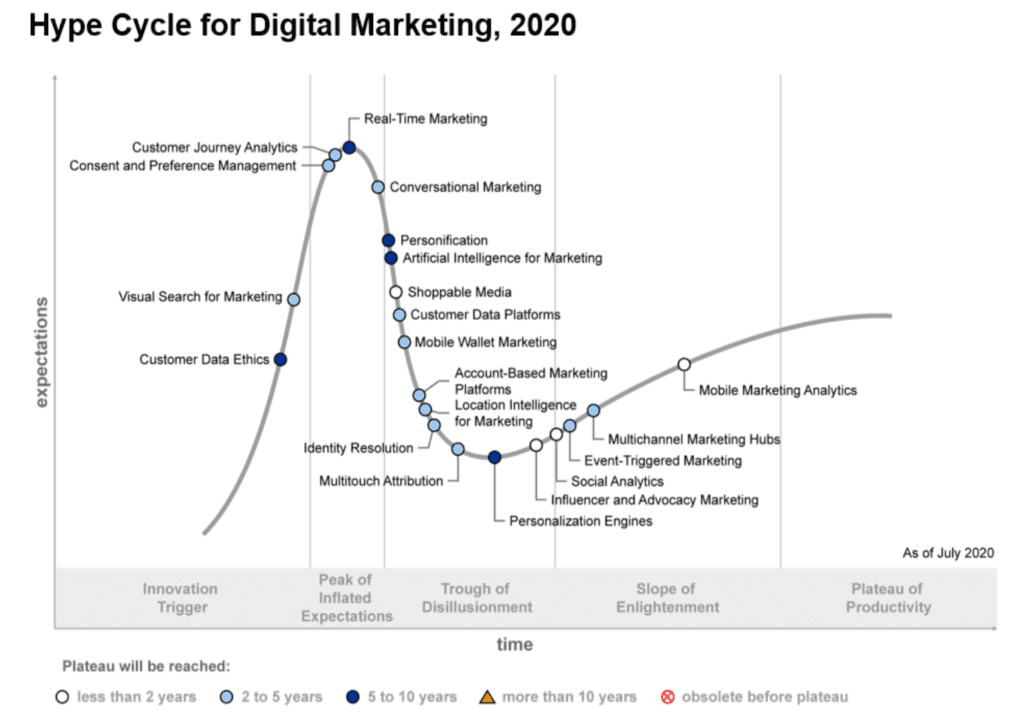
So we have a LOT of marketing options, some of which are at their “Peak of Inflated Expectations.” And some offer more certainty because they have or are reaching their plateau of productivity. With how much uncertainty we will be facing well into 2022, in 2021 bet on the digital marketing solutions that are in or reaching their plateau of productivity.
2. Misalignment Between Expectations of Fast Growth and What Will Be Possible
Not knowing what’s working doesn’t just come from the multitude of channels and options. It also comes from a misalignment between expectations, strategies and performance, both in delivering results but also in managing costs.
I’ve helped hundreds of executives gain clarity and the confidence to make sound decisions. We need to take the multitude of tactics executed by disparate teams and agencies and look at them as layers that contribute to a combined effect. No one digital channel will magically deliver results. But we continue to search for that magical channel or area that will give us sales immediately.
One of those channels expected to work miracles is paid advertising. This year we’ve seen an exponential increase in requests for paid advertising expected to work in a vacuum. Paid advertising can generate traffic to a website or email contacts immediately, but if those visitors come to a website that’s not compelling or Google you and see awful Glassdoor reviews, they’ll turn away and not come back a second time.
In the coming months, it will be tempting to look for that one thing that will erase the struggle of 2020 overnight. There is no such thing and if we waste time looking for it we’re going to fall behind. We are predicting increased competition as everyone shifts to digital marketing. We expect to see a lot of creativity and flexibility in the coming months, but that’s not limited to one channel. In the next six months, we will have to work harder and smarter than ever, across channels.
And while work takes time, where we see most time wasted is in making decisions. And if you don’t feel like you have the right information to make decisions, book a consult to review your options or an audit of your initiatives. Let’s talk. Don’t delay.
7. Understand the AI Marketing Solutions (We Predict Every Year)
Every single 2021 predictive digital marketing article will mention AI. And if you found one that doesn’t, please comment here or send me a DM (you can find me on pretty much any social network as @manamica).
I am really excited about AI-powered chatbots but they’ve been in development for years and we’re not quite there yet. Conversation bots have the potential for sales and relationship building. People do feel a sense of closeness to bots when they act like us. Bots can be useful but they need to learn from humans. And that will take more than a few years.
Marketers may run into AI in their everyday work. Google’s Smart Bidding technology will save PPC experts time and you won’t hear marketers talk about bidding strategies as much in 2021, whereas at one point in time it was a critical component of paid strategies.
What you can do:
- Check your expectations. For example, there are a lot of tools that label themselves at AI-powered content tools. But upon closer look, they each serve very specific needs. You can see a number of examples here.
- Ask what kind of human-like actions the technology replicates, based on what data set and how predictably.
- Expect to adjust processes to use tech where it can help and not try to fit a square peg in a round hole. Some things are best left to be done the old-school way.
Before I write a novel, let me stop here.
What are some of the most practical strategies in response to digital marketing trends and predictions you’ve read? Let us know in the comments.

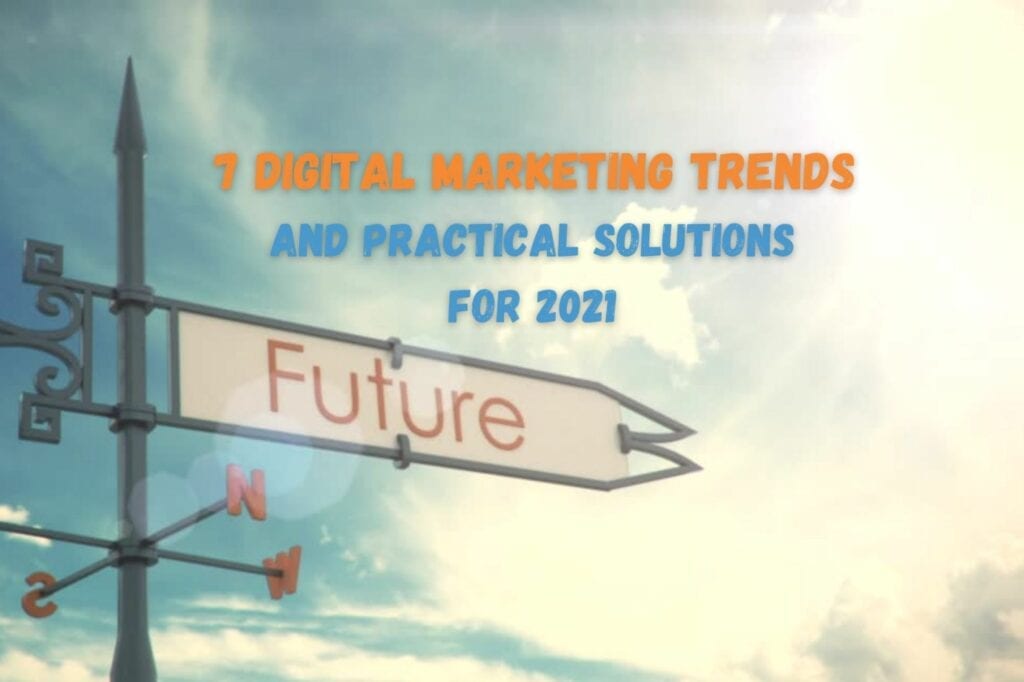
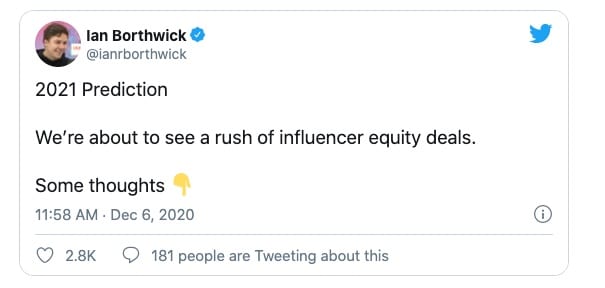
Leave a Reply